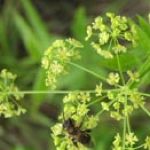| Common Name: |
Mountain Sweet Cicely |
| Other Names: |
Sweet Root, Western Sweet Cicely |
| Botanical Name: |
Osmorhiza occidentalis |
| Genus: |
Osmorhiza |
| Family: |
Apiaceae |
| Native Location: |
Western N America |
| Cultivation: |
Moist, well-drained soil in partial shade. |
| Propagation: |
By seed sown when ripe |
| Harvest: |
Leaves are picked when young and used fresh or dried. Unripe and ripe fruits are collected when ready, for use as flavorings. Roots are harvested from late summer to mid-autumn, after the plant has set seed, and used fresh as a vegetable, or dried for use in decoctions and tinctures. |
| Height: |
60cm-1.2m (2-4ft) |
| Width: |
30-60cm (12-24in) |
| Hardiness: |
Z6 |
| Parts Used: |
Leaves, seeds, roots |
| Properties: |
An aromatic herb that is carminative, laxative, and antifungal, and helps to lower blood sugar. It has anise-scented fruits, and roots with an aroma resembling anise or root beer. |
| Medicinal Uses: |
Internally for gastrointestinal infections, and constipation. Combined with Aralia nudicaulis (See, Wild Sarsaparilla) or Smilax spp. (See, Chinaroot), and Gycyrrhiza glabra (See, Licorice) for hyperglycemia. Externally as a douche for candidiasis, and wash for ringworm, athlete's foot, and other fungal infections. |
| Culinary Uses: |
Leaves are added to salad dressings and marinades. Dried, ground roots and fruits are used as a substitute for anise in baking. Leaves and roots are used to make tea. |
| Bibliography: |
Encylopedia of Herbs by Deni Brown Copyright ©: 1995, 2001 Dorling Kindersley Limited pg 298
|

